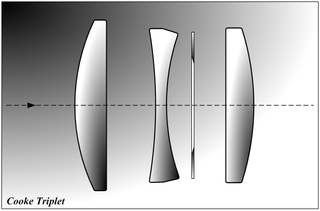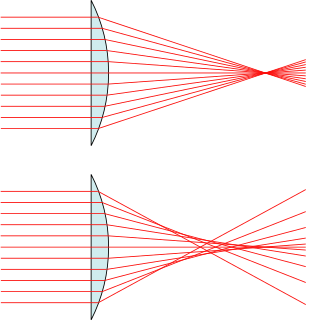Related Research Articles
A lens is a transmissive optical device which focuses or disperses a light beam by means of refraction. A simple lens consists of a single piece of transparent material, while a compound lens consists of several simple lenses (elements), usually arranged along a common axis. Lenses are made from materials such as glass or plastic, and are ground and polished or molded to a desired shape. A lens can focus light to form an image, unlike a prism, which refracts light without focusing. Devices that similarly focus or disperse waves and radiation other than visible light are also called lenses, such as microwave lenses, electron lenses, acoustic lenses, or explosive lenses.

Optics is the branch of physics that studies the behaviour and properties of light, including its interactions with matter and the construction of instruments that use or detect it. Optics usually describes the behaviour of visible, ultraviolet, and infrared light. Because light is an electromagnetic wave, other forms of electromagnetic radiation such as X-rays, microwaves, and radio waves exhibit similar properties.

In optics, chromatic aberration (CA), also called chromatic distortion and spherochromatism, is a failure of a lens to focus all colors to the same point. It is caused by dispersion: the refractive index of the lens elements varies with the wavelength of light. The refractive index of most transparent materials decreases with increasing wavelength. Since the focal length of a lens depends on the refractive index, this variation in refractive index affects focusing. Chromatic aberration manifests itself as "fringes" of color along boundaries that separate dark and bright parts of the image.

The Cooke triplet is a photographic lens designed and patented in 1893 by Dennis Taylor who was employed as chief engineer by T. Cooke & Sons of York. It was the first lens system that allowed elimination of most of the optical distortion or aberration at the outer edge of lenses.

In optics, spherical aberration (SA) is a type of aberration found in optical systems that have elements with spherical surfaces. Lenses and curved mirrors are prime examples, because this shape is easier to manufacture. Light rays that strike a spherical surface off-centre are refracted or reflected more or less than those that strike close to the centre. This deviation reduces the quality of images produced by optical systems.
Angular resolution describes the ability of any image-forming device such as an optical or radio telescope, a microscope, a camera, or an eye, to distinguish small details of an object, thereby making it a major determinant of image resolution. It is used in optics applied to light waves, in antenna theory applied to radio waves, and in acoustics applied to sound waves. The colloquial use of the term "resolution" often causes confusion; when a camera is said to have high resolution because of its good image quality, it actually has a low angular resolution. The closely related term spatial resolution refers to the precision of a measurement with respect to space, which is directly connected to angular resolution in imaging instruments. The Rayleigh criterion shows that the minimum angular spread that can be resolved by an image forming system is limited by diffraction to the ratio of the wavelength of the waves to the aperture width. For this reason, high resolution imaging systems such as astronomical telescopes, long distance telephoto camera lenses and radio telescopes have large apertures.
Optics is the branch of physics which involves the behavior and properties of light, including its interactions with matter and the construction of instruments that use or detect it. Optics usually describes the behavior of visible, ultraviolet, and infrared light. Because light is an electromagnetic wave, other forms of electromagnetic radiation such as X-rays, microwaves, and radio waves exhibit similar properties.

The resolution of an optical imaging system – a microscope, telescope, or camera – can be limited by factors such as imperfections in the lenses or misalignment. However, there is a principal limit to the resolution of any optical system, due to the physics of diffraction. An optical system with resolution performance at the instrument's theoretical limit is said to be diffraction-limited.
An optical system with astigmatism is one where rays that propagate in two perpendicular planes have different foci. If an optical system with astigmatism is used to form an image of a cross, the vertical and horizontal lines will be in sharp focus at two different distances. The term comes from the Greek α- (a-) meaning "without" and στίγμα (stigma), "a mark, spot, puncture".

The Maksutov is a catadioptric telescope design that combines a spherical mirror with a weakly negative meniscus lens in a design that takes advantage of all the surfaces being nearly "spherically symmetrical". The negative lens is usually full diameter and placed at the entrance pupil of the telescope. The design corrects the problems of off-axis aberrations such as coma found in reflecting telescopes while also correcting chromatic aberration. It was patented in 1941 by Russian optician Dmitri Dmitrievich Maksutov. Maksutov based his design on the idea behind the Schmidt camera of using the spherical errors of a negative lens to correct the opposite errors in a spherical primary mirror. The design is most commonly seen in a Cassegrain variation, with an integrated secondary, that can use all-spherical elements, thereby simplifying fabrication. Maksutov telescopes have been sold on the amateur market since the 1950s.

An aspheric lens or asphere is a lens whose surface profiles are not portions of a sphere or cylinder. In photography, a lens assembly that includes an aspheric element is often called an aspherical lens.
Optical lens design is the process of designing a lens to meet a set of performance requirements and constraints, including cost and manufacturing limitations. Parameters include surface profile types, as well as radius of curvature, distance to the next surface, material type and optionally tilt and decenter. The process is computationally intensive, using ray tracing or other techniques to model how the lens affects light that passes through it.

Athermalization, in the field of optics, is the process of achieving optothermal stability in optomechanical systems. This is done by minimizing variations in optical performance over a range of temperatures.

A microlens is a small lens, generally with a diameter less than a millimetre (mm) and often as small as 10 micrometres (µm). The small sizes of the lenses means that a simple design can give good optical quality but sometimes unwanted effects arise due to optical diffraction at the small features. A typical microlens may be a single element with one plane surface and one spherical convex surface to refract the light. Because micro-lenses are so small, the substrate that supports them is usually thicker than the lens and this has to be taken into account in the design. More sophisticated lenses may use aspherical surfaces and others may use several layers of optical material to achieve their design performance.
In physics, ray tracing is a method for calculating the path of waves or particles through a system with regions of varying propagation velocity, absorption characteristics, and reflecting surfaces. Under these circumstances, wavefronts may bend, change direction, or reflect off surfaces, complicating analysis. Ray tracing solves the problem by repeatedly advancing idealized narrow beams called rays through the medium by discrete amounts. Simple problems can be analyzed by propagating a few rays using simple mathematics. More detailed analysis can be performed by using a computer to propagate many rays.
Zemax is a company that sells optical design software. OpticStudio is its flagship product and a commonly used optical design program for Microsoft Windows. It is used for the design and analysis of both imaging and illumination systems.

Precision glass moulding is a replicative process that allows the production of high precision optical components from glass without grinding and polishing. The process is also known as ultra-precision glass pressing. It is used to manufacture precision glass lenses for consumer products such as digital cameras, and high-end products like medical systems. The main advantage over mechanical lens production is that complex lens geometries such as aspheres can be produced cost-efficiently.
TracePro is a commercial optical engineering software program for designing and analyzing optical and illumination systems. The program's graphical user interface (GUI) is 3D CAD-based creating a virtual prototyping environment to perform software simulation before manufacture.
Holographic optical element (HOE) is an optical component that produces holographic images using principles of diffraction. HOE is most commonly used in transparent displays, 3D imaging, and certain scanning technologies. The shape and structure of the HOE is dependent on the piece of hardware it is needed for, and the coupled wave theory is a common tool used to calculate the diffraction efficiency or grating volume that helps with the design of an HOE. Early concepts of the holographic optical element can be traced back to the mid-1900s, coinciding closely with the start of holography coined by Dennis Gabor. The application of 3D visualization and displays is ultimately the end goal of the HOE; however, the cost and complexity of the device has hindered the rapid development toward full 3D visualization. The HOE is also used in the development of augmented reality(AR) by companies such as Google with Google Glass or in research universities that look to utilize HOEs to create 3D imaging without the use of eye-wear or head-wear. Furthermore, the ability of the HOE to allow for transparent displays have caught the attention of the US military in its development of better head-up displays (HUD) which is used to display crucial information for aircraft pilots.
Optica is an optical design program used for the design and analysis of both imaging and illumination systems. It works by ray tracing the propagation of rays through an optical system. It performs polarization ray-tracing, non-sequential ray-tracing, energy calculations, and optimization of optical systems in three-dimensional space. It also performs symbolic modeling of optical systems, diffraction, interference, wave-front, and Gaussian beam propagation calculations. In addition to conducting simulations of optical designs, Optica is used by scientists to create illustrations of the simulated results in publications. Some examples of Optica being used in simulations and illustrations include holography, x-ray optics, spectrometers, Cerenkov radiation, microwave optics, nonlinear optics, scattering, camera design, extreme ultraviolet lithography simulations, telescope optics, laser design, ultrashort pulse lasers, eye models, solar concentrators and Ring Imaging CHerenkov (RICH) particle detectors.
References
- ↑ Rongsheng Tian; Charles S. Ih; K. Q. Lu, "Holographic optical system design using Super-Oslo", Proceedings of SPIE Volume: 1211 pp.90-98 (1990)
- ↑ Joel Herrera Vázquez; Sergio Vázquez y Montiel, "Optical design of a compact and anastigmatic telescope with three mirrors", Proceedings of SPIE volume 6342(2006)
- ↑ Paul K. Manhart; Xiaojie Xu, "Recent progress in macro axial gradient index optics (it's time to rethink gradients)", Proceedings of SPIE volume 2537 pp.250-260 (1995)
- ↑ Chongxi Zhou; Zhan Li; Dajian Lin; Chunlei Du, "Design of an off-axis infrared refractive/diffractive hybrid telescopic optical system", Proceedings of SPIE volume 2866 pp. 483-486 (1996)
- ↑ Dr. Joseph M. Howard, "Optical modeling activities for NASA's James Webb Space Telescope (JWST): IV. Overview and introduction of MATLAB based toolkits used to interface with optical design software", Proceedings of SPIE volume 6668 (2007)
- ↑ "Chieh-Jen Cheng; Jyh-Long Chern, "Design of aspheric lens to collimate and uniform irradiance of a light source with Lambertian angular distribution", Proceedings of SPIE volume 6342 (2006)
- ↑ Paul E. Murphy; Thomas G. Brown; Duncan T. Moore, "Optical vernier interferometry for aspheric metrology", Proceedings of SPIE volume 3676 pp. 643-652 (1999)
- ↑ Curtis J. Harkrider; Duncan T. Moore, "Time-varying boundary condition diffusion for gradient-index design", Proceedings of SPIE volume 3482 pp. 780-788 (1998)
- ↑ Dr. Joseph Howard, “Optical Design of Telescopes and other Reflective Systems using SLIDERS” https://ntrs.nasa.gov/api/citations/20080043876/downloads/20080043876.pdf "SLIDERS: the next generation of automated optical design tools has arrived" https://www.spiedigitallibrary.org/conference-proceedings-of-spie/5174/0000/SLIDERS--the-next-generation-of-automated-optical-design-tools/10.1117/12.506889.short
- ↑ "Archived copy" (PDF). Archived from the original (PDF) on 2011-07-20. Retrieved 2009-05-25.
{{cite web}}: CS1 maint: archived copy as title (link) - ↑ "OSLO Optics Reference" (PDF).